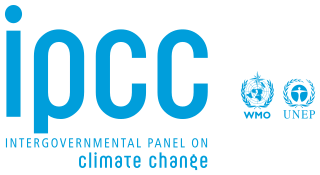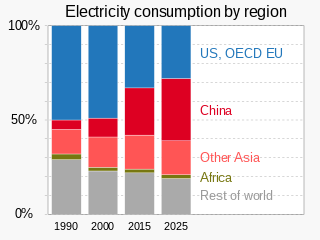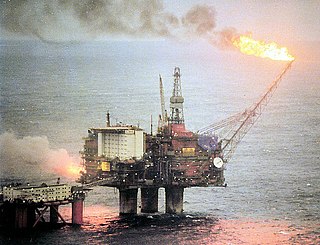The annual World Energy Outlook (WEO) is the International Energy Agency's (IEA) flagship publication on global energy projections and analysis. [1] It contains medium to long-term energy market projections, extensive statistics, analysis and advice for both governments and the energy business regarding energy security, environmental protection and economic development. The first WEO was published in 1977 and it has been an annual publication since 1998. [1]
The World Energy Outlook uses three scenarios to examine future energy trends. The Net Zero Emissions by 2050 Scenario is normative, in that it is designed to achieve specific outcomes – an emissions trajectory consistent with keeping the temperature rise in 2100 below 1.5 °C (with a 50% probability), universal access to modern energy services and major improvements in air quality – and shows a pathway to reach it. [2] The Announced Pledges Scenario, and the Stated Policies Scenario are exploratory, in that they define a set of starting conditions, such as policies and targets, and then see where they lead based on model representations of energy systems, including market dynamics and technological progress. The scenarios are not predictions but enable policy-makers and other readers to compare different possible versions of the future and the levers and actions that produce them, with the aim of stimulating insights about the future of global energy. [2]
Since 1993, the IEA has provided medium- to long-term energy projections using a continually-evolving set of modelling tools. In 2021, the IEA adopted the Global Energy and Climate Model to develop the world's first comprehensive study of how to transition to an energy system at net zero CO2 emissions by 2050. This model is now the principle tool used to generate detailed sector-by-sector and region-by-region long-term scenarios for the World Energy Outlook and other IEA publications. [1] [2]
| WEO Report Year | Changes/Methodology |
|---|---|
| 2000 | "The 1998 and earlier editions were based on a "business-as-usual" approach, which projected energy trends in a world where no new policies were enforced to limit climate change. This year's WEO introduced a new "reference scenario", which took into account those greenhouse gas policies that had been adopted and were in place in OECD countries." [3] |
| 2001 | |
| 2002 | "For the first time this year's Outlook extended its projection horizon to the year 2030." [4] |
| 2003 | "The WEO 2003 attempted for the first time in the report's history to quantify global energy investment needs, fuel by fuel and region by region." [5] |
| 2004 | |
| 2005 | "The 2005 edition presents a detailed assessment of energy prospects throughout the Middle East and North Africa region and the implications of these for world energy markets." [6] |
| 2006 | |
| 2007 | "The 2007 report presents a special focus on China and India and analyses the impact of rising energy use in these countries on the international energy markets and energy-related greenhouse gas emissions." [7] |
| 2008 | "The 2008 edition focuses on two pressing issues such as prospects for oil and gas production and the post-2012 climate scenarios." [8] |
| 2009 | "The 2009 edition presents in-depth analysis of three special topics: Financing energy investment under a post-2012 climate framework; prospects for global natural gas markets and energy trends in Southeast Asia." [9] |
| 2010 | "The 2010 WEO edition, released on 9 November 2010, presented for the first time in its history a scenario that takes account of the recent commitments that governments have made to tackle climate change and worsening energy insecurity. It also puts the spotlight on several topical issues, including the outlook for renewable energy technologies and unconventional oil, the implications of climate policies, Caspian energy prospects, energy poverty and energy subsidies." [10] |
| 2011 | "The 2011 report was issued on 9 November 2011. The executive summary noted that there were "few signs that the urgently needed change in direction in global energy trends is underway." Richard G. Newell, associate professor of energy and environmental economics at Duke University notes: "Even as mature economies moderate oil demand through efficiency and biofuels, emerging economies' oil demand for transport grows by almost 50 percent. The bottom line is, like it or not, we should be prepared for price swings at the pump for some time to come."" [11] |
| 2012 | "Fatih Birol, Chief Economist of the International Energy Agency (IEA) designed and directed the study which was prepared by the IEA's Directorate of Global Energy Economics of the International Energy Agency and other offices of the Agency. [12] Based on the New Policies Scenario, the central model used by the OECD's International Energy Agency, in Part A entitled Global energy demands, on the emerging global energy landscape, over the period to 2035, global energy demand would increase by more one-third with China, India and the Middle East accounting for 60 percent of that increase. [12] |
| 2013 | |
| 2014 | "This edition featured new projections which were extended, for the first time, to 2040." [13] |
| 2015 | |
| 2016 | |
| 2017 | "WEO 2017 introduced a major new scenario – the Sustainable Development Scenario – that outlines an integrated approach to achieving internationally agreed objectives on climate change, air quality and universal access to modern energy." [14] |
| 2018 | "The WEO 2018 series featured a special report on producer economies that explores how traditional oil and gas-exporting countries are adapting to a new price and policy environment, and what are the implications of longer-term structural changes in demand." [15] |
| 2019 | |
| 2020 | "The usual long-term modelling horizons were kept but the focus for the World Energy Outlook 2020 was firmly on the next 10 years, exploring in detail the impacts of the Covid-19 pandemic on the energy sector, and the near-term actions that could accelerate clean energy transitions." [16] |
| 2021 | |
| 2022 | "With the world in the midst of the first global energy crisis – triggered by Russia's invasion of Ukraine – the World Energy Outlook 2022 (WEO) focused analysis and insights on the implications of this profound and ongoing shock to energy systems across the globe." [1] |
| 2023 | "Publishing the 72nd Statistical Review of World Energy is a significant moment for the Energy Institute (EI)." [17] Download IEA Report [18] |

The Kyoto Protocol (Japanese: 京都議定書, Hepburn: Kyōto Giteisho) was an international treaty which extended the 1992 United Nations Framework Convention on Climate Change (UNFCCC) that commits state parties to reduce greenhouse gas emissions, based on the scientific consensus that global warming is occurring and that human-made CO2 emissions are driving it. The Kyoto Protocol was adopted in Kyoto, Japan, on 11 December 1997 and entered into force on 16 February 2005. There were 192 parties (Canada withdrew from the protocol, effective December 2012) to the Protocol in 2020.

Renewable energy is energy from renewable natural resources that are replenished on a human timescale. Using renewable energy technologies helps with climate change mitigation, energy security, and also has some economic benefits. Commonly used renewable energy types include solar energy, wind power, hydropower, bioenergy and geothermal power. Renewable energy installations can be large or small. They are suited for urban as well as rural areas. Renewable energy is often deployed together with further electrification. This has several benefits: electricity can move heat and vehicles efficiently, and is clean at the point of consumption. Variable renewable energy sources are those that have a fluctuating nature, such as wind power and solar power. In contrast, controllable renewable energy sources include dammed hydroelectricity, bioenergy, or geothermal power.

The International Energy Agency (IEA) is a Paris-based autonomous intergovernmental organisation, established in 1974, that provides policy recommendations, analysis and data on the global energy sector. The 31 member countries and 13 association countries of the IEA represent 75% of global energy demand.

Energy is sustainable if it "meets the needs of the present without compromising the ability of future generations to meet their own needs." Definitions of sustainable energy usually look at its effects on the environment, the economy, and society. These impacts range from greenhouse gas emissions and air pollution to energy poverty and toxic waste. Renewable energy sources such as wind, hydro, solar, and geothermal energy can cause environmental damage, but are generally far more sustainable than fossil fuel sources.

The Special Report on Emissions Scenarios (SRES) is a report by the Intergovernmental Panel on Climate Change (IPCC) that was published in 2000. The greenhouse gas emissions scenarios described in the Report have been used to make projections of possible future climate change. The SRES scenarios, as they are often called, were used in the IPCC Third Assessment Report (TAR), published in 2001, and in the IPCC Fourth Assessment Report (AR4), published in 2007. The SRES scenarios were designed to improve upon some aspects of the IS92 scenarios, which had been used in the earlier IPCC Second Assessment Report of 1995. The SRES scenarios are "baseline" scenarios, which means that they do not take into account any current or future measures to limit greenhouse gas (GHG) emissions.

Climate change mitigation (or decarbonisation) is action to limit the greenhouse gases in the atmosphere that cause climate change. Greenhouse gas emissions are primarily caused by people burning fossil fuels such as coal, oil, and natural gas. Phasing out fossil fuel use can happen by conserving energy and replacing fossil fuels with clean energy sources such as wind, hydro, solar, and nuclear power. Secondary mitigation strategies include changes to land use and removing carbon dioxide (CO2) from the atmosphere. Governments have pledged to reduce greenhouse gas emissions, but actions to date are insufficient to avoid dangerous levels of climate change.

Electric energy consumption is energy consumption in the form of electrical energy. About a fifth of global energy is consumed as electricity: for residential, industrial, commercial, transportation and other purposes. Quickly increasing this share by further electrification is extremely important to limit climate change, because most other energy is consumed by burning fossil fuels thus emitting greenhouse gases which trap heat.

Greenhouse gas (GHG) emissions from human activities intensify the greenhouse effect. This contributes to climate change. Carbon dioxide, from burning fossil fuels such as coal, oil, and natural gas, is one of the most important factors in causing climate change. The largest emitters are China followed by the United States. The United States has higher emissions per capita. The main producers fueling the emissions globally are large oil and gas companies. Emissions from human activities have increased atmospheric carbon dioxide by about 50% over pre-industrial levels. The growing levels of emissions have varied, but have been consistent among all greenhouse gases. Emissions in the 2010s averaged 56 billion tons a year, higher than any decade before. Total cumulative emissions from 1870 to 2017 were 425±20 GtC from fossil fuels and industry, and 180±60 GtC from land use change. Land-use change, such as deforestation, caused about 31% of cumulative emissions over 1870–2017, coal 32%, oil 25%, and gas 10%.

Norway is a large energy producer, and one of the world's largest exporters of oil. Most of the electricity in the country is produced by hydroelectricity. Norway is one of the leading countries in the electrification of its transport sector, with the largest fleet of electric vehicles per capita in the world.
The Energy Watch Group (EWG) is an international network of scientists and parliamentarians. The EWG conducts research and publishes studies on global energy developments concerning both fossil fuels and renewables. The organization states that it seeks to provide energy policy with objective information.

Climate change is an urgent and significant issue affecting Japan. In recent years, the country has observed notable changes in its climate patterns, with rising temperatures serving as a prominent indicator of this phenomenon. As an archipelago situated in northeastern Asia, Japan is particularly vulnerable to the impacts of climate change due to its diverse geography and exposure to various weather systems. The nation experiences a broad range of climates, spanning from the frigid winters of Hokkaido to the subtropical climates of Okinawa. Changes in temperature patterns have the potential to disrupt ecosystems, impact agricultural productivity, modify water resources, and pose significant challenges to infrastructure and human settlements.
Energy Technology Perspectives (ETP) is a publication on energy technology published by the International Energy Agency (IEA). The publication's goal is to illustrate how technologies can help achieve the objective of limiting the global temperature rise to 2°C and enhancing energy security.

Energy in Switzerland is transitioning towards sustainability, targeting net zero emissions by 2050 and a 50% reduction in greenhouse gas emissions by 2030.
The Copenhagen Accord is a document which delegates at the 15th session of the Conference of Parties to the United Nations Framework Convention on Climate Change agreed to "take note of" at the final plenary on 18 December 2009.
The Kyoto Protocol was an international treaty which extended the 1992 United Nations Framework Convention on Climate Change. A number of governments across the world took a variety of actions.
A climate change scenario is a hypothetical future based on a "set of key driving forces". Scenarios explore the long-term effectiveness of mitigation and adaptation. Scenarios help to understand what the future may hold. They can show which decisions will have the most meaningful effects on mitigation and adaptation.

Representative Concentration Pathways (RCP) are climate change scenarios to project future greenhouse gas concentrations. These pathways describe future greenhouse gas concentrations and have been formally adopted by the IPCC. The pathways describe different climate change scenarios, all of which were considered possible depending on the amount of greenhouse gases (GHG) emitted in the years to come. The four RCPs – originally RCP2.6, RCP4.5, RCP6, and RCP8.5 – are labelled after a possible range of radiative forcing values in the year 2100. The IPCC Fifth Assessment Report (AR5) began to use these four pathways for climate modeling and research in 2014. The higher values mean higher greenhouse gas emissions and therefore higher global surface temperatures and more pronounced effects of climate change. The lower RCP values, on the other hand, are more desirable for humans but would require more stringent climate change mitigation efforts to achieve them.

An energy transition is a major structural change to energy supply and consumption in an energy system. Currently, a transition to sustainable energy is underway to limit climate change. As much sustainable energy is renewable it is also known as the renewable energy transition. The current transition aims to reduce greenhouse gas emissions from energy quickly and sustainably, mostly by phasing-down fossil fuels and changing as many processes as possible to operate on low carbon electricity. A previous energy transition perhaps took place during the Industrial Revolution from 1760 onwards, from wood and other biomass to coal, followed by oil and later natural gas.

World energy supply and consumption refers to the global supply of energy resources and its consumption. The system of global energy supply consists of the energy development, refinement, and trade of energy. Energy supplies may exist in various forms such as raw resources or more processed and refined forms of energy. The raw energy resources include for example coal, unprocessed oil & gas, uranium. In comparison, the refined forms of energy include for example refined oil that becomes fuel and electricity. Energy resources may be used in various different ways, depending on the specific resource, and intended end use. Energy production and consumption play a significant role in the global economy. It is needed in industry and global transportation. The total energy supply chain, from production to final consumption, involves many activities that cause a loss of useful energy.
This article documents events, research findings, scientific and technological advances, and human actions to measure, predict, mitigate, and adapt to the effects of global warming and climate change—during the year 2023.